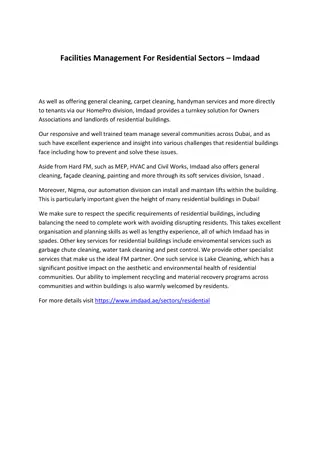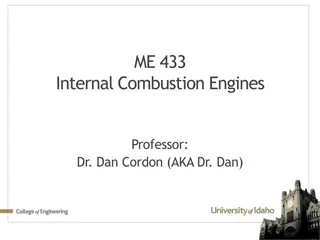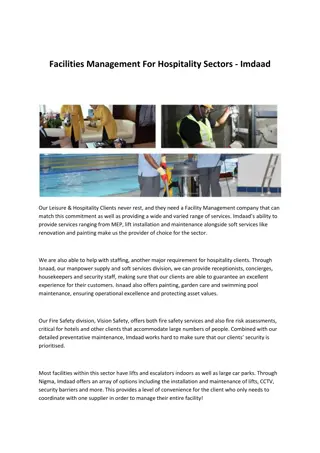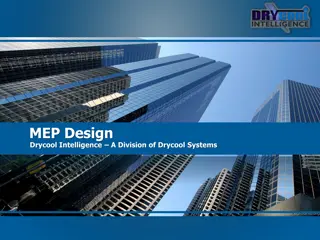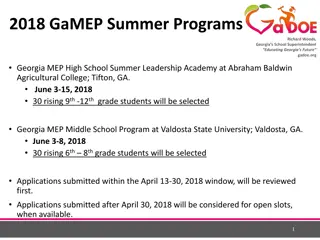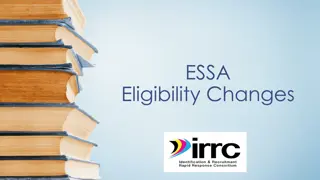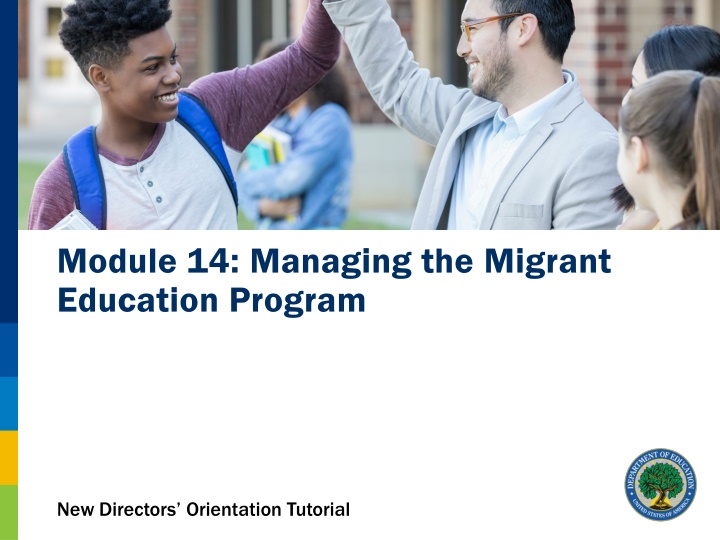
Guide for New Directors in Managing Migrant Education Program
Explore Module 14's comprehensive tutorial for new state directors on managing the Migrant Education Program. Learn to organize work, identify support, and prioritize tasks effectively.
Uploaded on | 0 Views
Download Presentation

Please find below an Image/Link to download the presentation.
The content on the website is provided AS IS for your information and personal use only. It may not be sold, licensed, or shared on other websites without obtaining consent from the author. If you encounter any issues during the download, it is possible that the publisher has removed the file from their server.
You are allowed to download the files provided on this website for personal or commercial use, subject to the condition that they are used lawfully. All files are the property of their respective owners.
The content on the website is provided AS IS for your information and personal use only. It may not be sold, licensed, or shared on other websites without obtaining consent from the author.
E N D
Presentation Transcript
Module 14: Managing the Migrant Education Program New Directors Orientation Tutorial
Table of Contents Section Section Slide # Slide # Getting Started 3 Migrant Education Program - The Big Picture 8 Managing the Work 13 Wrapping Up 28 2
Getting Started In This Section In This Section Tutorial Objectives How to Use the Tutorial Icons to Guide You 3
Tutorial Objectives Module 14 will help state directors to 1. organize the work required to manage the Migrant Education Program (MEP), 2. identify people who can guide and support them, and 3. prioritize their tasks. 4
How to Use the Tutorial For optimal benefit from the tutorial, you should allow sufficient time to read the slides, reflect on the information, and complete all activities on the slides or on the Quick Resource and Reflection Sheets (QRRS) that can be downloaded as worksheets; read each slide as well as the information referenced in the slides; engage with the What Do You Think? slides to facilitate interaction with the information (Answers will be provided directly following each of these slides.); 5
How to Use the Tutorial For optimal benefit from the tutorial, you should (continued) pause to reflect on your state program at the Check-in slides (A QRRS document will typically accompany these.); complete the Pop Quiz! slides to reinforce key concepts; review your state s MEP documents and reports as directed; develop an action plan using the worksheets provided; add actionable items to your MEP planning calendar (See QRRS 14.2); and contact your OME Program Officer for follow-up questions. 6
Icons to Guide You The following icons will guide you in making the best use of this tutorial: What Do You Think? Check-in Pop Quiz! Quick Reference and Reflection Sheet (QRRS) Action Planning Calendar Item 7
Migrant Education Program - The Big Picture In This Section In This Section A Complex Program Role of the State Director 8
A Complex Program The MEP has Many layers Many components, e.g., o Federal o ID&R o State o Local operating agency (LOA) oversight o Regional and/or Local o Program Planning Many stakeholders o Child Count and Data Collection o Cross-program Coordination o Migrant children o Interstate Coordination o Parents o Intrastate Coordination o Educators o Participation in National Activities o Program administrators o Parent Involvement o Service providers 9
Role of the Migrant Education Program State Director The state director is the official within his/her State educational agency (SEA), responsible for: Professional development and training, Cross-program coordination, and Oversight of the MEP, Monitoring and quality control. Program planning, Fiscal management, Contract management, Data collection, Coordination of all MEP components, 10
What Do You Think? What do you think are your three biggest challenges as a MEP state director? 1. 2. 3. See QRRS 14.1 Addressing the Challenges of Being a State Director 11
What Do You Think? - Reflection Following are common challenges state MEP directors have identified. How many of your challenges are on this list? Understanding the many requirements for the program. Coordinating all components. Needing more expertise in a variety of areas. Meeting the needs of a wide range of stakeholders. Finding sufficient time and support to carry out responsibilities. 12
Managing the Work In This Section In This Section Organizing the Work Identifying Supportive Contacts Creating Capacity Prioritizing Activities Keeping Abreast of New Information and Emerging Issues Keeping the Main Thing the Main Thing 13
Organizing the Work Strategies Strategies Develop a master calendar based on the action plans in the tutorials. o Review all QRRS Action Planning sheets from the modules and compile a master action plan and calendar. o The master calendar may need to cover three to five years. o This activity will give you an idea of what resources, expertise, and capacity you need to carry out tasks. Develop an organization chart for the MEP so that you and other staff members can see how all components interrelate and what the lines of responsibility are. See QRRS 4.2 MEP Master Calendar 14
Organizing the Work Strategies Strategies Organize the following information for easy reference: o Law, regulations, guidance; o Technical assistance documents; and o State MEP documents and reports. 15
Organizing the Work Strategies Strategies Familiarize yourself with these federal and state administrative requirements and protocols: o Federal reporting requirements, o Local monitoring, o Fiscal management, o Contracting, and o Data collection. 16
Identifying Supportive Contacts Strategies Strategies Identify and utilize people in the SEA who can guide you and help navigate administrative channels. Keep all local, state, and national MEP contact information up-to-date and accessible. Identify and utilize state directors in other states who can share practical information on implementing the MEP. Identify and utilize experienced LOA administrators and recruiters who can assist with understanding state and local contexts for implementing the MEP. Identify and utilize people who can provide additional expertise you need in areas such as data analysis, evaluation, staff supervision, or team facilitation. Work on creating partnerships within your agency and with others who work in your agency, in LOAs, and in nonprofit organizations. 17
Creating Capacity Strategies Strategies Devote sufficient time to train state MEP staff, LOA administrators, and ID&R coordinators and recruiters so that they can carry out their responsibilities effectively so that less of your time will be required for ongoing technical assistance. Delegate tasks as appropriate to other MEP staff (e.g., LOA administrators may be willing to present at state conferences or mentor new administrators). 18
Prioritizing Activities In the course of the day, you are likely to face a number of challenges and tasks that need attention. Keep in mind that not all tasks are of equal importance. Often, taking care of something important in a systematic and comprehensive way will take more time now but will prevent the issue from becoming a crisis later. Utilize a master action plan and calendar to keep you on track with what you need to accomplish by certain deadlines. 19
Prioritizing Activities One way to approach multiple demands is to look at Stephen Covey s Seven Habits of Effective People. Covey suggests that work can be categorized into four quadrants: Urgent (needs immediate attention), Not Urgent (does not need immediate attention), Important (must be taken care of), and Not Important (does not need to be taken care of) Note: In the next slide, these quadrants might look for the work you do. 20
Prioritizing Activities Urgent Not Urgent Quadrant I Quadrant I Submitting a report by a deadline Addressing incorrect COEs Following up on a parent complaint Quadrant II Quadrant II Creating a policy for interstate records exchange Conducting recruiter training Monitoring LOAs Important Important Quadrant III Quadrant III Attending mandatory meetings not related to the MEP Searching through files to find information in preparation for federal monitoring Quadrant IV Quadrant IV Responding to every email as it arrives in your office, rather than prioritizing which ones need to be answered immediately Traveling to a face-to-face meeting when a conference call would suffice Not Important Not Important 21
Prioritizing Activities More on Covey s Quadrants: Effective people try to spend as much time as they can in Quadrant II and to limit time spent in Quadrant IV. Prioritizing your work by determining in which quadrant the task would fall can help you decide where to spend your time. A number of tasks may begin in Quadrant II but become crises for Quadrant I tasks if not addressed. 22
Check-in Instructions: Estimate what percentage of your time each day on the job that you spend on activities in each of the quadrants below. What improvements do you need to make? Urgent Urgent Not Urgent Not Urgent Important Important Quadrant I Quadrant I Quadrant II Quadrant II Not Important Not Important Quadrant III Quadrant III Quadrant IV Quadrant IV Listing daily activities in the appropriate quadrants will help you prioritize your work. See QRRS 14.3 Prioritizing Your Work 23
Keeping Abreast of New Information and Emerging Issues Migrant education is constantly changing and reflecting the nature of the migrant population. New research, demographic trends, and strategies can inform services, and federal laws and policies can impact educators and migrant families. It is important that you build into your schedule sufficient time to stay current on all relevant issues. 24
Keeping Abreast of New Information and Emerging Issues Strategies for keeping up to date: Attend as many migrant-specific national conferences and national trainings as possible. Stay abreast of your state s migrant-specific data needs; bookmark the MSIX website. Join LISTSERVs that will keep you informed of new research and policy developments. Build in time each week to review new information. 25
Keeping the Main Thing the Main Thing Above all, keep in mind that the focus of the work is to enable migrant children to be successful in school and beyond. The work you do should make a difference in the lives of migrant children and families. In a world of competing agendas and shrinking resources, missions can get overlooked. 26
Keeping the Main Thing the Main Thing Questions to keep in mind: Do I feel like the work I do benefits the lives of migrant children? On a day-to-day basis, do I feel like the majority of the small tasks I do contributes to improving the MEP? Which of my tasks do not contribute to improving the MEP, and how can I minimize the time devoted to these tasks? 27
Wrapping Up In This Section In This Section Key Points Action Planning Resources 28
Key Points 1. Working from a master action plan and calendar will provide you with direction for accomplishing required tasks across program components. 2. Spending time gathering technical assistance resources and state MEP documents will save time later when you need these for quick reference. 3. Having a system for prioritizing your time will enable you to choose the tasks that are most important and will help avoid crises. 4. It is important to remind yourself frequently what the work is really about. 29
Action Planning 1. Revisit QRRS 14.1 to generate strategies that will help you address your challenges in serving as the MEP state director. 2. Add items to your MEP master calendar. 3. Utilize the template provided in QRRS 14.3 on a regular basis to categorize tasks in the quadrants according to their importance and urgency. Add any actionable items to your MEP planning calendar. 30
Resources for Managing the Work MEP Guidance on Education of Migratory Children under Title I, Part C, of the Elementary and Secondary Education Act of 1965 Explanation of guidelines to implement the laws and regulations related to the MEP Covey, S.R. (1990). The 7 Habits of Highly Effective People. NY: Simon & Schuster. o Includes inspiration and strategies for using time effectively. 31
Migrant Education Program Resources MEP Officers MEP Officers List of OME contact information (https://results.ed.gov/about/contact) Glossary of Terms Glossary of Terms Alphabetical listing of key terms applicable to migrant education (https://results.ed.gov/idr- manual/section/glossary/glossary) 32



